Menus
- Winning return
- To those who doubted the involvement of Yamaha in enduro, despite its rich history and success, the new 250 WR-F opposes an end of inadmissibility. Yes, the brand is still interested in the discipline. Yes, she always knows how to produce beautiful and good machines. And no, she does not…
- An endless wait ….
- Racy presentation
- An original plastic…
- A driving position to cut the wind.
- On a hike
- To attack….
- In crossing
- Conclusion
Winning return
To those who doubted the involvement of Yamaha in enduro, despite its rich history and success, the new 250 WR-F opposes an end of inadmissibility. Yes, the brand is still interested in the discipline. Yes, she always knows how to produce beautiful and good machines. And no, she does not let go! Quite the contrary !
It’s always the same thing, we are eternally dissatisfied. Take the case of the 250 WR-F. In the community, its notoriety reached new heights. Ask any enduro rider, he will be happy to confirm it to you. This motorcycle is a monument. Reliable, rigorous, homogeneous, easy, it is the tool for those who wish to start walking the paths of our beautiful country. It is the “always on the road” and beginner’s bike that it will never disappoint and which, incidentally, will always be able to resell it at a good price, its reliability being legendary. It is a reference, which explains its long career in the Yamaha catalog since, if you count well, since 2001, it has throne in the dealerships of Blues. Only here, despite this minister’s suit, there is something wrong with the old WR-F: his great age. Playing extra time in the catalogs, ok, but doing it without technical upheaval, off-road, is not an option. Because here, who does not advance, retreats. And quick. If therefore, the WR-F had a good reputation among budding enduro riders, epicureans, hikers, cushy dads, among others, competitors, pendulum hunters, scratch warriors, its aura was quite different. Lymphatic to see amorphous in the engine, soft in the suspensions, a bit long in the frame, some did not hesitate to dislike it, or even to assimilate it to a trail with an enduristic vocation. The supreme insult…

An endless wait ….
It was therefore high time for the brand to react, whose history is closely linked to the discipline. The concern was that by dint of waiting, we had almost lost our illusions. In 15 years, only one vintage had delighted us, that of 2007, with its model with an aluminum frame. A chassis strongly inspired by that of the cross model, released a year earlier and which had significantly improved the rigidity and stability of the beast in the fast, as the sex appeal. Except that the engine had gone downhill…. Finally, it was only a tiny minority who thought this was the right year. Already because 2014 saw the unloading of a brand new 250 YZ-F, a copy of its big sister, the 450, with its inverted cylinder, its injection feed and its completely new overall architecture (admission behind the steering column, tank slipped under the saddle …) and then because behind the scenes, rumors were rife. Especially in this period when the brand was showing unprecedented dynamism. We are talking about the incredible MT07, MT09, the 125 and 400 X-Max, the Tricity … The Blues are on the rise so necessarily, their enduro could not miss the boat. Especially since three years ago, they had the delicacy to serve us a revamped 450 WR-F, mixed with the chassis of the 250 and the engine base of the old model brought up to date, understand, injected and well revamped internally. In short, we were calculating something huge, it is there! Hallelujia !

Racy presentation
If they have the same engine dimensions (77 x 53.6) and distribution by double ACT, it is a technological revolution between the old and new WR-F. The same one that the Blues had engaged in 2010 when they released the first series cross with reverse cylinder and tilted backwards, the 450 YZ-F (considering that the Cannondale MX 400 released in early 2000 had not really reached series). A machine which had made a milestone and which remains the direct source of inspiration for the new YZ-F and WR-F, also equipped with the famous engine architecture and injection. Now, we’ll see, some differences are emerging ….
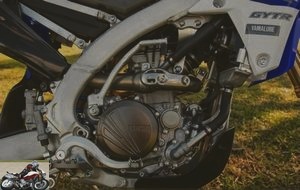
Thus, if we find the same intake system in front of the block, almost vertical to the cylinder, to force-feed the engine with pure and fresh air, all the programming of the control unit has been revised. The hunt for maximum power has been replaced by the search for maximum availability, the holy grail in enduro. Gearbox and clutch also evolve in concert to adapt to the constraints of the discipline: the first gains a new stage, with a short first, an extended sixth and extended 2nd, 3rd and 4th ratios, when springs and clutch discs see their thicknesses increased to better withstand long waxing sessions. The return of the mechanism is also a bit longer to reduce the effort required. Essential accessory, the electric starter makes its appearance in front of the cylinder while an alternator borrowed from that of the 450 is responsible for providing a little more juice to the entire power plant, logically more demanding on the WR-F which has, you noticed it from a lighting and a dashboard.
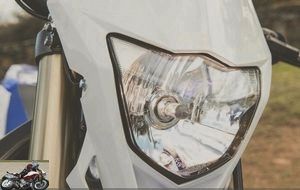
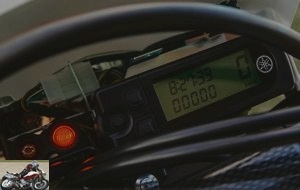
That said, the lower casings are identical on the two cousins. Particular care was taken in the cooling of the beast. We can notice it in the presence of a fan behind the right radiator (as on the KT), but the press kit also indicates the change of the axis of the turbine by a hard treated element. Criticized on the cross model for its excessive sound, the exhaust is muzzled by the only part reminiscent of the old model, its silencer. In aluminum, oval in shape, it seems imposing but achieves the goal set since the Blues assured us to pass without incident under the 112 db regulations. It is all the more surprising that the collector, of the snake type, seems completely identical to the cross model..
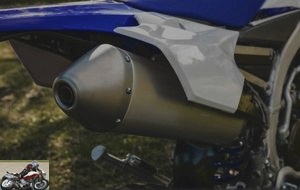
Finally, that concludes the game of 7 differences between cross country and enduro. A game that ends up affirming the kinship between the two almost identical blocks, which bodes well for the performance level of the young lady…
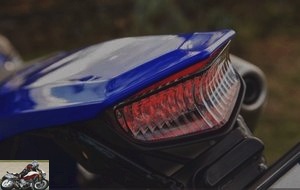
An original plastic…
Standardization requires, the chassis is also very close to the cross model. Same frame, same swingarm, same Kayaba 48mm diameter twin-cartridge fork, Yamaha stuck to minimum rpm. Either an 18 ‘rear wheel, an O-ring chain kit, an upper triple clamp with two saddle settings (but at the same offset) and a 10 mm longer shock absorber so that you can ride with a little preload. higher than on the YZ-F.
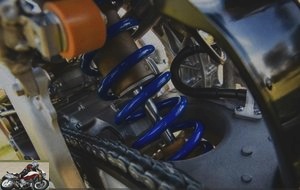
It’s not much, but the WR-F is a typical machine nonetheless. In particular because of the specific location of the elements, following the original engine architecture. Access to the air filter is via a hatch held by three screws located at the fuel cap, which has migrated to the end of the saddle, under a removable cover, held by three lugs. Pieces that also inspire a hint of skepticism about their aging ….
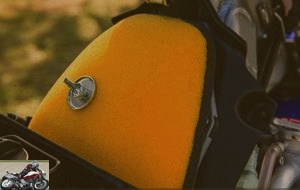
It is the same for a good part of the connections, moved under the saddle, against the rear wheel arch. In the open, we remain cautious about the little protection it enjoys and if at Yam we are assured of having done a series of tests, the tightness of all these sockets after a season of washing with Karcher or worse, a good gardening in good groves. thick, stay suspended … Seems it will hold. The tank has the same capacity as the element of the cross model with 7.5 liters (0.5 liters less than the previous model), which allows without problem to complete the 90 kilometers of loops that are encountered in league enduro.
A driving position to cut the wind.
From the outset, the contrast between new and old model is striking. Gone is the feeling of sitting in a chair below the handlebars, in the middle of the bike. Like on the YZ-F, you have the feeling of being seated on the front wheel, with your chest straight, very close to the driving position with the footrests a bit high. The saddle flat and a firm hair, has a lot to do with it. We feel ready for the attack. The straight handlebars at the right height also help load the front end of the machine and you can feel that when cornering, to push down on the front wheel, it should be okay…. On the other hand, the bike also amazes by the prominence of its radiator gills and integrated intake ducts. It is much larger and more imposing than on the old one which remained exemplary on the chapter, despite its years of existence. To use a metaphor, it feels like a bulldog, ready to pounce. An impression reinforced by the fact that the machine’s wheelbase appears to have been shortened (only seems since the values are the same). Otherwise, nothing to report on the controls, always exemplary of softness and precision. One finger is enough to disengage and brake.

In short, it is only happiness, even if you have to get used to this relative overweight! As it should be done with the absence of contact cut. Now, a simple press on the starter is enough to put the beast in tension while a timer takes care of putting it "out of order" after a minute of standby. A little more in terms of pleasure.
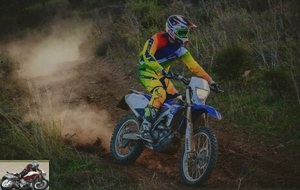
On a hike
Come on, let’s get started on the chapter that made the old WR-F a benchmark, hiking. First positive point, the bike does not seem noisier than the old one. The big silencer, a bit unsightly by the way, fulfills its role perfectly. La Bleue plays with discretion, even when it tickles the breaker. On the other hand, it should be noted that it emits an intake noise much more present than yesterday.
The block makes its inhalation of pure air clearly heard in the front of the saddle, which can surprise a hair. To see to annoy some of them, the sensitive ones of the Eustachian tubes…. This being the case, the machine remains royal when it comes to traveling the world: its engine knows how to be gentle on the gas net, elastic and the box, with six reports against five for the old model, is a smoothness and precision model. While engine braking remains limited. As for the chassis, a bit firmer than the old one, more rigid too, it has the good idea not to go overboard. Everything is carefully balanced and you don’t have to fight against a manly frame, to impose your will on it. On the contrary, because of its compactness, it is even more natural in turnstiles, or even more playful. To the point where the difficulty would almost be to maintain a senatorial rhythm…. The 2-hour test loops designed by Yamaha did not allow the maximum autonomy of the 7.5-liter tanks to be tested, but one can reasonably expect more than a hundred kilometers of freedom. That is enough to consider beautiful walks in isolated regions. In short, walking in WR-F, it’s done with your fingers in the nose.

To attack….
The main course and the moment when you can’t help but congratulate Yamaha on the quality of their work. As expected, the inverted block produced its good effects on the behavior of the block and its cavalry. Yesterday wise in its revving and limited in its maximum output, the new engine is now furious and downright impressive power. Like its cross counterpart. The contrast is striking. Gone are the days of crass clutch pickups to try and grab a loose rev range. Now, the slightest acceleration of the wrist translates into a good kick in the rear end. It’s very electric, so a lot more playful…. and incomparably more efficient. Especially since the Yam has the good idea to combine all this vitality of endless reach and barely noticeable engine braking. Again, nothing to do with the menu offered yesterday. The injection settings are optimal: the feeling at the throttle is very faithful and it is perfectly possible to control the arrival of power. A plus when the driving conditions are plump. The box shines once again for its precision, speed and staging. In load, on the fly, the reports pass without worry. Another joy, the cycle part. Until then, a WR-F was a rail that nothing could deviate from its path. A TGV served by soft suspensions, very soft even, but which did not flinch, except on big shocks where fork and shock absorber could violently tail off. Today, a WR-F is a scalpel. A very short, very rigid chassis served by a perfect suspension combination (despite its lack of break-in) which reads the track with real fidelity. In short, we can play with the holes, the bumps, when yesterday we had to suffer them. It’s much more fun. Afterwards, on the other side of the coin, we did not find this serenity of the front axle, especially on the angle, which until then allowed us to roll our eyes almost closed. It sounds a bit more fickle, though, once again, the 2015 F takes the corners with an ease that will make the old one green with envy. The price to pay for an otherwise funky motorcycle ….

In crossing
Blessed are the Blues who had thought of embellishing the trial link with a rock climb to gauge their baby’s ability to overcome the crossing. Before the exercise, one would have thought that the vitality of the block would play tricks on the dashing young lady and that in the end, she did not do much better, or even worse, than the old one whose anemic block demonstrated incredible efficiency in tricky passages. But no, missed! There too the Yam is royal. This is due both to its astonishing engine power, that which allows you to turn in two, or to drive under full revs when hiking and to its perfect electronic management which allows a very fine dosage of gas. With the clutch being ideally progressive, all you need to do is focus on the right grip and you can get away with it, feel the rear tire bite the dirt and push you to the top. In first, as in second !

Braking side, that of the Yam is correct. In fact, in enduro all braking systems are roughly the same, with the exception of the slightly more powerful Brembos, KTs and HVAs. But those of the Japanese and Sherco work more than correctly…. this is also what should be understood by "a finger on the lever is enough"
Conclusion
We won’t go so far as to recognize that it was worth the wait 8 years to finally see this new WR-F land, the wait having been far too frustrating, but we must admit that with this machine, Yamaha suddenly made up for lost time over the past decade. See even, being a little ahead of the friends, which attests to an obvious know-how in enduro. Next, this machine makes two observations. Already, betting on an inverted cylinder engine, designed for absolute performance, was a brilliant idea as the Blues knew that calming the fury of the block was doable with good mapping. Or how to build a “good for everything” engine inexpensively…. Afterwards, it is funny to notice that Yam’s recipe for attracting the “green” customer remains the same as that used for the road, namely to produce machines with a strong character and a very racy angular design. An output that is therefore fully integrated into the overall policy of the brand in tuning forks, even if we may regret that it did not follow the same pricing policy as for the MT09 and MT07, the announced selling price being just under the bar of 9,000 (8,990) euros, the upper range of enduros 4T. Afterwards, it is clear that we are no longer really old enough to believe in Santa Claus ….
Strong points
- Homogeneous motorcycle
- Powerful and fun engine
- Aggressive look
- Instinctive chassis
- Finish quality
- Possibility of modifying the engine via the Power Tuner which acts on the mapping
- Discretion
Weak points
- Overweight in the front of the machine
- Muffler identical to the old model
- Locking the front axle at high speed
The technical sheet of the Yamaha WR250F 2015
Related articles
-
Upgrading Unchanged since 2012, the Yamaha 450 WRF has this time been completely revisited. Derived from the excellent YZF cross model, this new Yamaha…
-
Two-Temperaments ! At the end of the 1970s, when motorcycles with large-capacity multicylinder engines weighing a dead donkey have been in vogue for a…
-
The bête noire of conformism 3 cylinders in line, 889 cm3, 119 hp and 93 Nm, 189 kg, 9,499 euros With its MT-09, Yamaha revolutionized the market for…
-
200 hp at 13,500 rpm, 112 N.m at 11,500 rpm, 199 kilos with full fuel, from € 18,499 Is the Crossplane engine an advantage in road use ? Even if the…
-
Backpacker at heart Twin-cylinder CP2 of 689 cm3, 74 hp and 68 Nm, 204 kg full made, 9,699 euros Stopped at the end of 2016 due to Euro 4 standards, the…
-
Single cylinder, 292 cm3, 28 hp at 7,250 rpm, 29 Nm at 5,750 rpm, 179 kilos, € 5,899 Yamaha’s mid-size scooter gets a makeover and gets traction control…
-
Yamaha VMax 1700 motorcycle test
The return of a legend The return of the good, the bad and the tonic-truante. Certain celestial objects cross our orbit according to a periodicity which…
-
2015 vintage Thirteen years since the TMax made its appearance with several major evolutions since the TMax 500 cm3. If the maxi scooter evolves again in…
-
The scooter missing between 250 and 530 cm3 in tune XMax 125, XMax 250, TMax 530…. one could have imagined that Yamaha would go hunting on the roads of…
-
Yamaha TMax 560 TechMax maxi-scooter test
Standard vs TechMax: which model to choose ? Twin cylinder of 562 cm3, 47.6 hp and 55.7 Nm, 218 kg, from 11,990 euros 7th generation! Yes the Yamaha TMax…